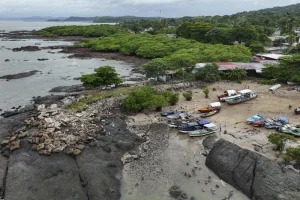A 9.1 magnitude earthquake also caused a tsunami in the city of… See more

Japan has been struck by its most powerful earthquake in 140 years. The 8.9 magnitude tremor hit early Tuesday morning near Miyagi Prefecture on the northeast coast. The quake lasted over a minute, shaking buildings violently as far as Tokyo, over 300 kilometers away.
Seismic alarms alerted many people, allowing for evacuation, but more than 3,000 deaths have been confirmed, with thousands still missing. A massive tsunami followed, with waves over 10 meters flooding coastal towns and sweeping homes, cars, and boats inland.
Japan’s prime minister declared a national disaster and urged calm, saying, “This is a disaster of historic magnitude. But Japan has risen again before, and it will do so again.” Hospitals are overwhelmed, and over 1.5 million homes are without power. Food, water, and essential supplies are scarce.
Rescue efforts are underway by Japan’s Self-Defense Forces and international teams. One major concern is the damage to nuclear plants, especially Fukushima, where cooling systems have been severely affected. A 20-kilometer radius around Fukushima has been evacuated due to fears of radioactive leaks.
Seismologists have called this the strongest earthquake recorded in Japan’s modern history and the worst since the 1923 Great Kanto Earthquake. The energy released was equivalent to hundreds of atomic bombs.
Countries including the U.S., South Korea, Germany, and Mexico have sent aid and support. Despite the devastation, the Japanese people are showing remarkable resilience, with volunteers organizing to help the affected and donation centers receiving widespread support.
Rebuilding will take years, but the spirit of Japan remains strong, ready to recover from this tragic event.
Tsunami evacuations ordered in South America, but worst risk appears to pass for US after huge quake
HONOLULU (AP) — Fears of a devastating tsunami across the Pacific faded Wednesday after one of the strongest earthquakes ever recorded struck off a sparsely populated Russian peninsula, but communities along South America’s Pacific coast carried out evacuations and closed beaches.
Warnings in the first hours after the 8.8 magnitude quake sent people fleeing to rooftops in Japan and forced tourists out of beachfront hotels in Hawaii, snarling island traffic. One death was reported in Japan, and in Russia, several people were hurt while rushing out of buildings, including a hospital patient who jumped from a window.

Millions of people were told to move away from the shore or seek high ground because they were potentially in the path of the tsunami waves, which struck seaside areas of Japan, Hawaii and the U.S. West Coast but did not appear to cause any major damage.
The dire warnings following the massive quake early Wednesday off Russia’s Kamchatka peninsula evoked memories of catastrophic damage caused by tsunamis this century.
In Japan, people flocked to evacuation centers, hilltop parks and rooftops in towns on the Pacific coast with fresh memories of the 2011 earthquake and tsunami that caused a nuclear disaster.
Cars jammed streets and highways in Honolulu, with traffic at a standstill even far from the sea.
“We’ve got water, we got some snacks … we’re going to stay elevated,” said Jimmy Markowski, whose family from Hot Springs, Arkansas, fled their Waikiki beach resort before evacuation orders were lifted. “This is our first tsunami warning ever. So this is all new to us.”

U.S. Secretary of Homeland Security Kristi Noem said the worst had passed. Later Wednesday, tsunami advisories for Hawaii, Alaska, Oregon and Washington state were canceled but remained for parts of northern California, where authorities warned to stay away from beaches and advised that dangerous currents should be expected through Thursday morning.
Experts say it’s challenging to know when to drop advisories, which signal the potential for strong currents, dangerous waves and flooding.
“It’s kind of hard to predict because this is such an impactful event and has created so many of these waves passing by,” said Dave Snider, tsunami warning coordinator for the National Tsunami Warning Center in Alaska.
Among the world’s strongest recorded quakes
The earthquake was the strongest recorded since the 9.1 magnitude earthquake off Japan in 2011 caused a massive tsunami and meltdowns at a nuclear power plant. Japan’s nuclear plants reported no abnormalities this time.
Wednesday’s quake occurred along the “Ring of Fire,” a series of seismic faults around the Pacific Ocean. It was centered offshore, about 120 kilometers (75 miles) from Petropavlovsk-Kamchatsky, Kamchatka’s regional capital. Multiple aftershocks as strong as 6.9 magnitude followed.
Russia’s Oceanology Institute said tsunami waves of less than 6 meters (20 feet) were recorded near populated areas of the peninsula.
Lava flowed Wednesday from the Northern Hemisphere’s largest volcano in a remote area of Kamchatka, the Russian Academy of Sciences’ geophysical service said.

3 countries in South America lift tsunami warnings
In South America, three of the four countries with coastlines on the Pacific lifted their tsunami warnings.
Authorities in Colombia, Ecuador and Peru announced that tsunami alerts were removed. In Chile, the country with the largest Pacific coastline in South America, the government kept the alert along most of the coastline but lifted it in some areas where authorities said there was no longer a risk.
Chile’s Interior Minister Álvaro Elizalde said late Wednesday that evacuation orders remain in force in areas with alerts in place, and that schools will be closed again on Thursday.
He said a wave in one location measured 8.2 feet (2.5 meters), while in other areas they reached a height of 3.6 feet (1.1 meters).
Chile is highly vulnerable to earthquakes and tsunamis.
Hawaii downgrades to tsunami advisory
Authorities in Hawaii downgraded the state to a tsunami advisory, and evacuation orders on the Big Island and Oahu, the most populated island, were lifted.
“As you return home, still stay off the beach and stay out of the water,” said James Barros, administrator of the Hawaii Emergency Management Agency.
In northern California, tsunami waves of 3.6 feet (1.1 meters) were recorded in Crescent City, which has a history of tsunami disasters.
Even waves of just several feet high might pose a significant risk.

“It might only be 3 feet, but it’s a wall of water that’s 3 feet and spans hundreds of miles. Three feet of water can easily inundate inland and flood a couple blocks inland from the beach,” said Diego Melgar, director of Cascadia Region Earthquake Science Center at the University of Oregon.
